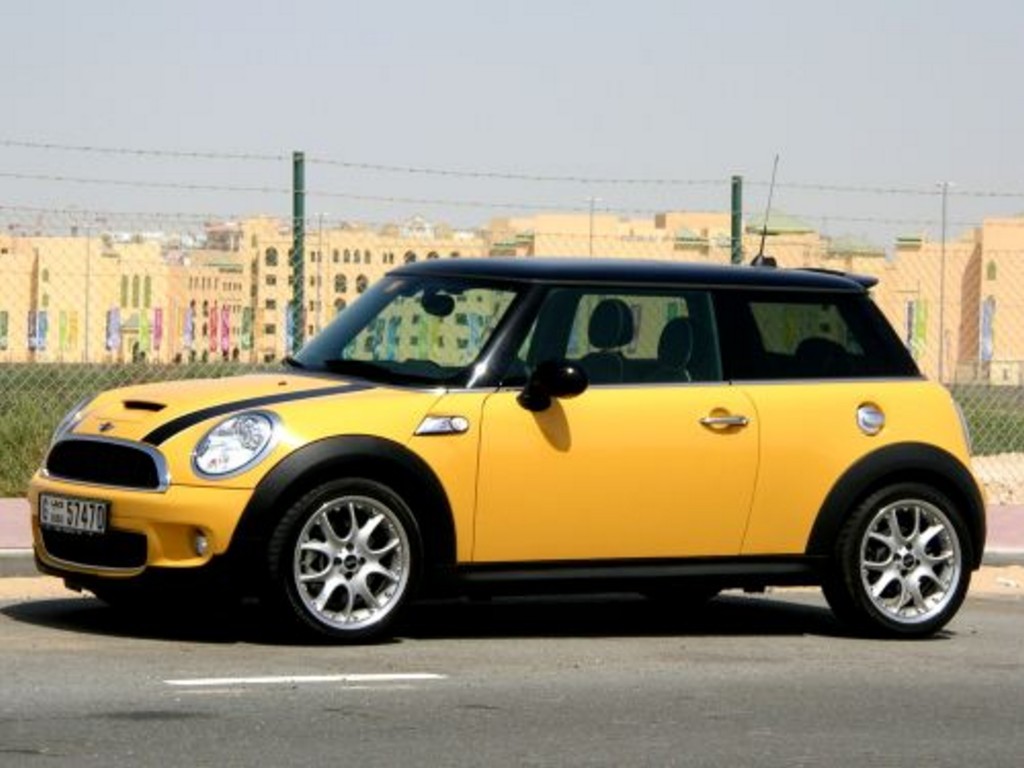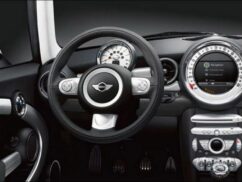2008 Mini Cooper S

| The Good: – Great around the curves – Turns a lot of heads – Cool unique interior design |
The Bad: – Pretty pricey for its size – Possible electronic gremlins – Rear seat fits only small animals |
Some say the Mini is a chick car. We tend to somewhat agree, but only if it is a basic One model with an automatic and a lipstick-matched paintjob. The legendary Mini has received a complete makeover for this model year, and the Cooper S that we drove takes a hell of a lot of stamina to drive. Our BMW-supplied turbocharged S tester even looked mean enough to shake off any preconceptions of it being a mall-hopper for teenage girls. And it drew a surprising amount of looks and requests for rides from strangers, given that it looks a lot like the old model. This is quite possibly the smallest car in the market to garner any sort of respect on the road.
Our yellow Cooper S, with large rims, central twin exhaust tips and optional hood stripes, is easily an attractive car. Climbing into the cabin causes only slight discomfort, as the heavily-bolstered seats are designed for zero tolerance to squirming. The cabin design is a big improvement over the previous one, while still preserving its trademark quirkiness. Everything has an odd shape, including the stereo, gauges and door handles, while a lot of functions are controlled by toggle switches, including the windows and the sunroof. The interior trim is a good mix of soft plastics, hard plastics, metallic-looking plastics and chrome-plated plastics. Interestingly, there is a swathe of real aluminium along the dashboard, although this expensive thought is offset by some flimsy plastics such as under the sun-visors. Other contradictions include a complete integrated navigation system and a CD changer in a cool hidden dash compartment. And yet the frameless doors close with a cheap thud, while the seats are all manually operated.
Speaking of seats, the sporty leather buckets fit us like gloves, but we doubt fatter folks will find them comfortable. Space up front is good enough, even though it all feels a bit tight. But in the rear, it is only slightly more spacious than a soda can. We somehow slipped into the back seat, but the front seats had to be moved well forward just to create useable legroom. The luggage area will fit only one medium-sized suitcase at most, although the rear seat back can also fold down to make some more cargo room. This is as good as it gets in the new “enlarged” Mini.
For small items, there is a cool button-operated hidden glovebox, some door pockets and a small tub under the a/c controls. The tiny central armrest can only hold one mobile phone. There are also two exposed cup-holders up front, while rear passengers have to share one.
The feature set includes power windows, electric mirrors, cruise control, front and side-curtain airbags, rear parking sensors and a fully keyless entry and start system. Also included is a solid pounding CD stereo integrated within the navigation system screen, with speakers all over the car. The screen display is controlled using a tiny knob similar to the more advanced iDrive system in BMWs, so playing with settings takes ages. The screen itself is set within the huge funky central speedometer, while there is a secondary gauge cluster behind the steering wheel with a traditional tacho and a digital speedo too. The a/c is fairly good, but it has to be turned all the way up to have any effect. Part of the cooling issue might be due to the optional panoramic glass roof of our tester, which only has a perforated shade to shield occupants from the sun. Also, a weird electrical issue meant the wipers started up sometimes when we turned the car off.
The turbocharged 1.6-litre four-cylinder engine is a raging piece of work. It makes its presence known through an exhaust note loud enough to wake up neighbours under full throttle. It grumbles like a much larger engine, although it pumps out only 174 horses at 5500 rpm. Obviously that’s enough juice for this lightweight car, given that 240 Nm of torque help things along from as low as 1600 rpm all the way to 5000 rpm, with no discernible lag. We matched the 0-100 kph factory time of 7.1 seconds in the middle of summer. This required keeping wheelspin under control with a clutch-drop launch at only 3000 rpm. Because this is a front-wheel-drive setup, the hood rises up and the front tyres lose grip during launch, blowing away a lot of power with spinning wheels. There is also a noticeable amount of side-to-side torque steer during the first couple of gear changes, so a firm grip on the steering wheel is required to keep the car straight. Interestingly, our car was delivered with a non-functioning stability control system, so we drove this car to its real limit. Of course the electronic nannies could be turned off at the press of a button, if it did work.
Our car was the six-speed manual version, which made it infinitely more engaging to drive. A lot of people might opt for the optional six-speed automatic though, because even though the firm shifter-clutch-steering setup is ideal for driving hard, it is a pain in city traffic. Thankfully the pain has been reduced in this new model compared to the old one, as the setup is somewhat softer than before. The shifter still takes time to get used to, since first gear and reverse are side-by-side, and we were always stressed out over whether we might fly off in the wrong direction. Four days with the car helped to overcome this uncertainty.
While the firmness of its controls can be an annoyance in city traffic, its size still makes it a cinch to park. The engine vibrates a bit at idle though, so the drive always felt manic even when we were trying to relax. The ride quality is firm, but not too jarring and easily bearable on the daily commute. Out on the highway, potholes of course feel like craters, while road noise from the firm run-flat tyres is deafening at anything more than 120 kph. Thankfully, wind noise and exhaust rumble seems to be minimal at speed, although maybe they just got drowned out by the roaring tyres. All this amounted to a fuel consumption figure of 10.4 litres per 100 km, which is slightly more than that of our previous Honda Civic tester.
The real reason why this pricey little thing is an enthusiast favourite is the handling. It handles like a go-kart, with only a tiny hint of body roll. It retains its point-and-shoot character thanks to low-profile rubber wrapping the optional 17-inch rims, and we could never make the 205/45 tyres squeal while taking high-speed corners, even though we drove without the safety net of dynamic stability control. The torque steer is manageable on take-off, while braking is very strong, with the four-wheel-disc brakes bringing the car to quick easy stops. As we drove hard, we could feel everything that was going on in and around the car through our hands, our feet, our ears and our asses. Few cars beyond the BMW family offer this much involvement.
The redesigned Mini Cooper S may still look like the previous model, but it really is an improvement over the old one. It still aims for total driving enjoyment of the illegal kind but, in our minds, it is still not practical enough to be a daily commuter-mobile or grocery-getter. Awesome second car though.












Comments
fares
MINI Coopers great car and strong and I want to get this giant